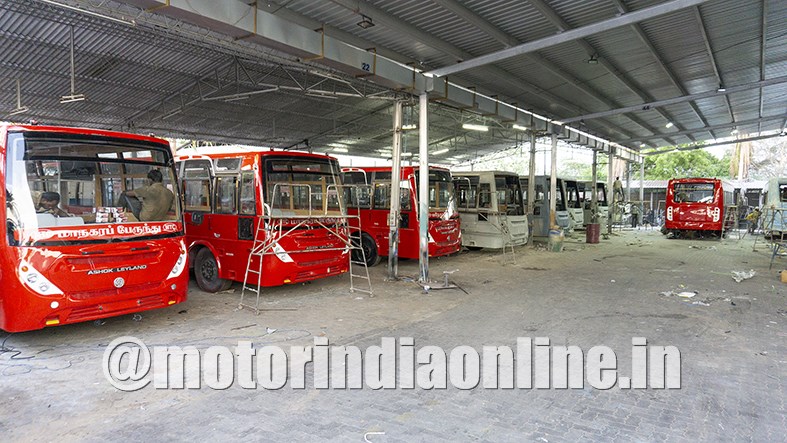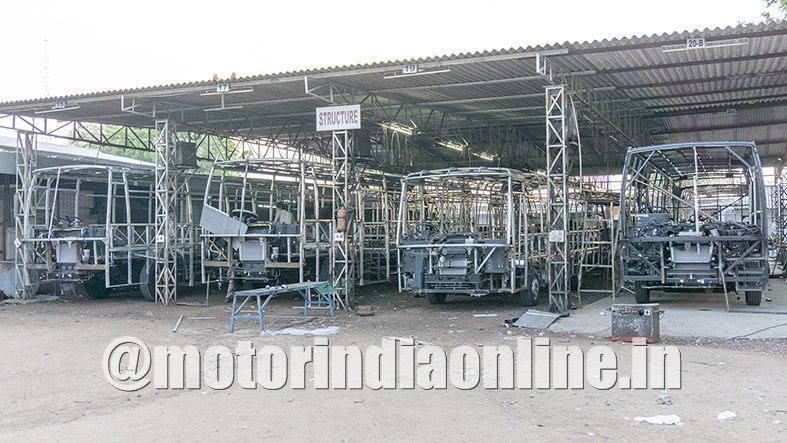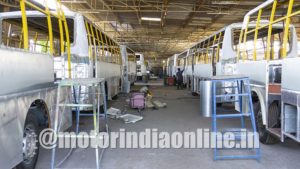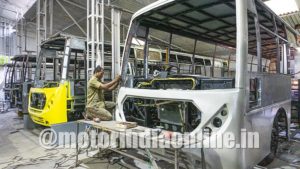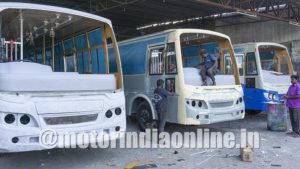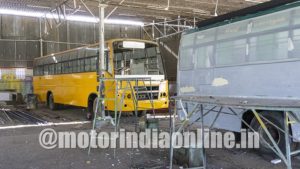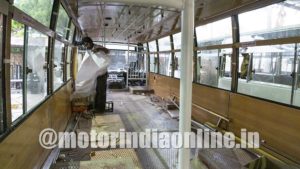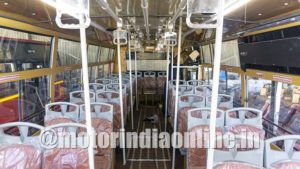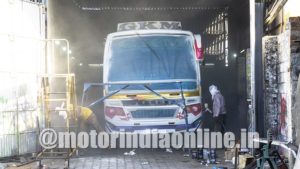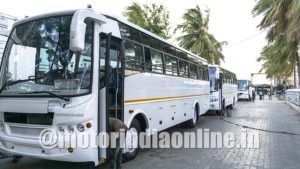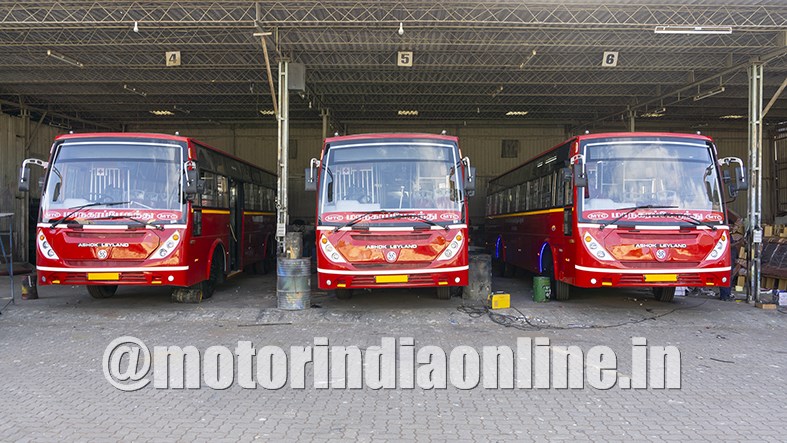One of the largest clusters of bus body building in South India, Karur caters to a wide customer base in the peninsular region extending up to Maharashtra and Orissa, along with Andaman Islands. Ever since its emergence in the 1980s, the town’s bus fabrication industry has stood up to changing times, although the disruptive scenario in the last five years has hurt it so badly beyond any imminent recovery. MOTORINDIA investigates a multitude of factors that lead to the downtrend and figure out the way forward towards resumption and growth of the industry.
I grew up in a tiny town situated some 17 km north of Karur in Tamil Nadu along the National Highway 44 (previously NH 7), the longest running highway connecting the north and south extremes of the country. Being situated on the path of NH has brought a lot of prosperity to the Karur district which can be considered the central point of the State of Tamil Nadu. Since my home was highway-facing, just yards away from it, I naturally became a connoisseur of road and the vehicles plying on it!
Karur, representing the entrepreneurial spirit of the central region of Tamil Nadu, is a major hub of textile manufacturing, bus body fabrication and commercial agriculture. These activities kept the highway even more busy, and what always caught my attention at that time were those newly-built buses leaving Karur. That was the time when the local bus body builders got a lot of inter-State orders, and the new buses had to use the then two-lane highway to return back to their home State. They usually moved as a convoy of three or more buses and frequently stopped at my doorstep for a break.
Further, my relation with Karur-built buses goes beyond connoisseurship. I also grew up travelling in those buses all long, may it be for my everyday school commute, week-end trips to kins in the neighbouring districts, or even inter-State transit. Buses were like ‘dreamliners’ for middle-class folks like us until we started owning a car, and they actually looked like one! Even today, buses built in Karur have a unique flavour of their own, in terms of styling and customisation.
Vivid colour schemes and jazzy imprints of flowers, butterflies, animals or cine stars mark all private stage carriers in the State, thanks to the superior prowess of the Karur bus body builders. They can execute any imagery or paint scheme the customer wants, and the operators are always keen to differentiate their buses with dynamic visual appearances that attract passengers. Not just that, the buses built here are also known for their robustness and innovation in steel body or FRP, also in terms of material selection for seating and interior trims, uncluttered wiring for in-cabin lighting and entertainment systems, and so on.
Early emergence
Karur’s tryst with bus body fabrication began with L G Balakrishnan & Bros (LGB) in the 1950s – a private bus operator from Coimbatore who established a body fabrication shop to cater to their own fleet. Decades later, in the 1980s and 1990s, some determined employees moved out of LGB to establish their own businesses, which gave the initial boost. From time to time thereon, partners of those newly established companies started falling out, which led to the proliferation of the industry.
“That was the time when the demand for buses in South India increased greatly, especially with the expansion of STUs, privatisation of educational institutions and the emergence of the IT industry. So, there was a fair quantum of business for all the players, which helped the body fabrication industry to grow”, says Mr. M. Balaji, Secretary of the Association of Tamil Nadu Coach Builders, and partner at Hari Bus Coach, Karur. However, the bus industry went through a series of regulatory and market-induced changes disrupting the momentum, which reached its peak with the implementation of AIS 052 – the Code of Practice for Bus body Design and Approval.
The industry was always receptive to changes, but the advent of the bus code made a lasting impact on the Karur bus body builders, opines Mr. Soundararajan, Director – Maaruthi Coach Builders. “This was a leap in the whole new direction, which requires fabricators to build their capacities and resources for design and development. Investment for certification compliance was costly and severely impacted our revenue, while alternative mechanism like cluster approach was not allowed either, making the situation worse”, he adds.
In 2015, the Association of Tamil Nadu Coach Builders made a representation to the MoRTH to be recognised as a SME cluster with single accreditation for bus body design, as it would be economical and less disruptive for the stakeholders. “But the Ministry mandated that each bus body builder has to get certified for the designs individually, which have cost us dear”, says Mr. Balaji.
A couple of years on, around 70 per cent of the fabricators in the town have successfully received certification from ARAI and CIRT, he estimates. Certification processes are smooth, except for the expenses involved in it which ranges from Rs. 15 lakhs to even several crores for big players depending on the number of designs and variants, he adds.
On the horns of a dilemma
In addition, even those big players who applied for certification were caught in a predicament. Says the Managing Director of Peetee Coach Builders Mr. Muruganantham: “Previously, Karur builders were fabricating a wide variety of buses, including multiple variants of city-buses, stage carriers, tourist and staff buses, school buses and others based on a number of chassis available in the market. During the initial talks on certification, we were of the impression that there would be a common application for variants grouped under four type categories. I initially gave the drawings and spec details for over 250 variants to get certified”.
But the applicants came to know only later that separate applications have to be filed for each and every type and variant, which proved to be taxing. He explains: “For instance, for a bus of a stipulated seating capacity, the wheelbase of chassis supplied by one OEM may differ from another by a matter of just a few mm, say one chassis may have a wheel-base of 4,600 mm but a chassis from an another brand may have 4,650 mm. But the seating capacity and the rest of the body parameters are going to remain the same”. This means that fabricators are forced to invest more and secure certification for ‘n’ number of chassis variants, as they are unsure which chassis their customers are going to bring for fabrication.
Mr. Muruganantham resents: “I have invested on certification of those chassis variants for which there are hardly any takers, not even sure of any return in future. I simply paid for approval of a chassis variant just for one customer of mine who adds not more than just one bus a year, so that I don’t lose him”. This means fabricators are now working on select chassis variants for which they have secured certification, which has limited the business of the Karur industry to a great extent.
He also says that certification processes are transparent. The certification agency first studies all the designs that the fabricators submit and identifies the worst case of the lot, which has to be prototyped by the applicant for further scrutiny and final approval.
On the brighter side, bus code accreditation requires fabricators upgrading to the CAD design and engineering requirements, while also requiring chassis details and other engineering aspects from manufacturers, which then has to be checked for roll-over protection. Software and prototyping add to their cost of operation, so does hiring right professionals to redesign the code-compliant structure, steel channels, floor materials and body trims, seating configuration, electrical wiring, and so on. “This is tedious and next-to impossible for unorganised fabricators and new entrants in the industry, as it would make a big dent in the profit margin for each bus manufactured”, says an industry insider and large-scale builder who does not want to be named. “This has effectively kick-started technological upgradation and mechanisation of bus body fabrication in Karur in an unprecedented manner”, he adds.
Mr. Balaji further observes: “The bus code was being talked about for over 15 years since 2001, and the implementation has brought uniformity in bus body building, with no compromise on the required quality and safety levels. Customers may now see our products on par with the OEM-built buses, even helping us to compete as per international standards”.
However, the bus code turned out to be fatal for many in the local industry, which is dominated by SMEs in terms of workforce the industry supports. For Mr. P. Balasubramanium of Super Coach Builders, the bus code and the market scenario that ensued left him with limited orders, as he couldn’t compete with large players.
“It has become a norm these days that only large-scale fabrication of buses can be successful, with hardly any scope for small players to compete or collaborate. This condition is further worsened by GST, BS-IV price hike and soaring diesel prices, which have all increased the cost for operators and hence no replacement of fleet as expected before”, he observes. With a capacity to manufacture at least 20 buses per month, his company is juggling with just 2 or 3 buses these days. The condition is even more miserable for those small fabricators who have not applied for certification yet. Since bus code-compliance is mandatory for RTO clearance, they are either dormant or simply undertaking body repairs of older buses.
The fiasco doesn’t end with bus code compliance for the fabrication industry here. “The bus industry is not what it was before. Demand for buses from private educational institutions and IT companies have reached a saturation point, which means no explosive induction of new buses beyond the natural replacement cycle”, says a body builder who requested to stay anonymous.
Procurement of new buses by the Tamil Nadu State Transport Corporation Ltd. (TNSTC) also did not catch up to the rising demand, and procurement is now on only after a long gap, he noted.
Around 10 large players from Karur have received the latest TNSTC orders for new buses, catering to more than 90 per cent of stage carriers and city bus orders issued by the State Government.
Moreover, private bus fleets in the region are deferring their purchases and continue to use their existing buses that are already due for replacement. Apart from the deteriorating profitability owing to increasing diesel prices and other factors, private operators find bus code-compliant buses undesirable due to the restriction on seats from the previously 60-plus to just 54 seats for stage carriers, according to industry observers.
Adds Mr. Muruganantham: “As per the revised norms, the increased width of seats has reduced the gangway in buses and thus limited the space for standees. This affects their revenue, especially for stage carriers. Limited gangway also puts passengers at a disadvantage when they have to quickly exit the vehicle in case of an emergency”.
Fluctuating orders is perhaps the biggest factor that continues to create a sense of uncertainty for the bus body industry in Karur. However, replacement of private buses is getting better in the last few months, and together with the bagged STU orders and bookings from other States, the builders are gaining some momentum. “A good number of orders are coming from the neighbouring States like Kerala and Karnataka, while the mood of local private bus operators still remains hard to predict”, said Mr. Soundararajan of Maaruthi Coach Builders. However, it is to be noted that only large-scale builders with high capacity and experience end up attaining L1 in STU tenders, and the smaller units are left out.
Further, the threat from fully built buses (FBB) manufactured by OEMs is largely looming among the coach builders. “The FBB concept was already gaining momentum even before the bus code implementation, especially in the school and staff bus segments. Today, over 60-70 per cent of demand has already shifted to FBBs… but not the mofussil bus and other segments”, notes Mr. Muruganantham. Nevertheless, OEM-built buses are the greatest threat to their survival, he agrees while adding that body fabricators may end up assembling their own chassis to ensure their survival if FBBs continue to hold sway in future.
Hope and determination
“If that’s imminent, we may then have to join hands with chassis manufacturers as body fabrication partners. The brand value of a chassis still determines the value of the buses, so it is uncertain whether bus buyers would opt for own chassis assembled in-house as against a popular OEM”, Mr. Balaji observes. To him the biggest threat as of now is the lack of skilled labour and quality workforce, who have dispersed across multiple body building and repair units that have come up in the region in the last decade. “Governments can encourage apprenticeship of ITI and diploma students in the Karur bus body industry through relevant amendments to the Apprenticeship Act. This can create a new generation of skilled workforce to sustain the industry in future”, he suggests.
The coach builders seem unsure of what impacts the industry would have with the onset of the BS-VI emission norms from April 2020. But they all agree that there are no signs of pre-buying happening in the bus industry this year. “The growth of the overall bus industry, with increased chassis sales at OEM and higher replacement among fleets, is essential for the bus body building industry to sustain. But that was hardly the case in the last five years, ever since 2012. However harsh the market scenario is, we are moving with a hope that things may better in future”, avers Mr. Balasubramanium. Just as any SME industry in the country these days, the Karur bus body industry is also vigorously trying to come out of the troubled waters.
